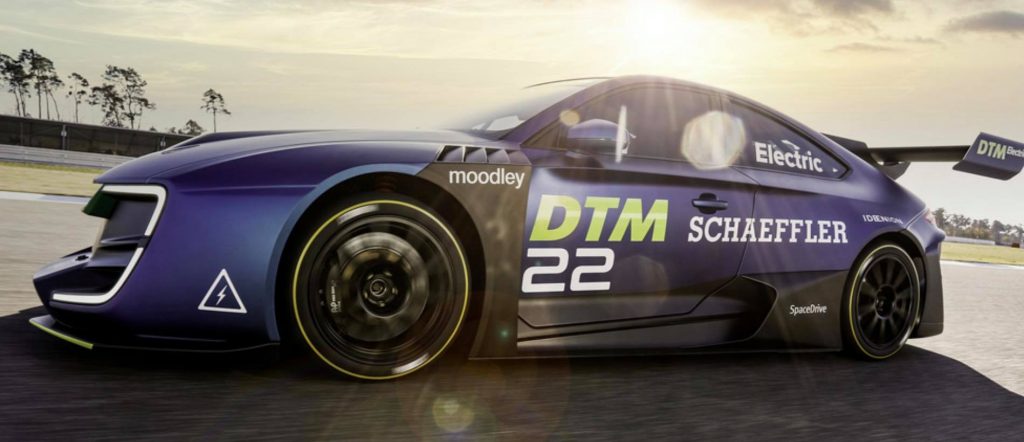Though, admittedly, I don’t usually rank amongst its most avid watchers, I can absolutely appreciate the allure of Touring Car. There is something greatly appealing about taking a road car that you (hypothetically) could go out and buy, being pushed to their absolute limits around some of the best racetracks in the world. Touring cars are big, powerful and noisy, and that makes them great!
Well… they might not be very noisy for much longer… as DTM, one of the world’s leading touring car divisions (competed between Audi and BMW backed teams) have announced plans to stage an all-electric racing series from 2023.
No! Stop! Don’t panic! Don’t go rushing to change.org desperately looking for the petition to stop this ‘ruination’ of racing! The DTM Electric championship will run separately to existing hybrid series, so internal combustion isn’t dying out in motorsport… yet. Once you know of DTM’s ambition to run its all-electric championship as a separate division and can put aside that instant fan reflex to resist change, then the possibilities it presents for the future of Touring Car becomes rather interesting.
And, yes, this announcement will come as a shock to some. After all, DTM’s promoter ITR is headed by Gerhard Berger- a man most famous for winning Formula One races in V12 McLarens and Ferraris. Just last year, Berger himself said that electric racing was “Not our DNA” and that he had “not seen many spectacular races with electric technology.” Berger has scorned talks of DTM switching to electric in the immediate future, and yet, just a year later: here we are!
For others, this news will not be that surprising at all, because when you look at the cold facts of this proposal- it just makes sense. Audi and BMW both have ambitions to pioneer electric production cars, with both manufacturers stating their goals of having at least 25 unique models of electric vehicles on the market by 2025. There have also been major backers of a shift to electric powertrains within the sport, including 2016 Formula One World Champion Nico Rosberg, who in an interview last year with Motorsport.com said that DTM “Must be electric” to secure its long-term future. Though Nico and his father Keke are both better known for their personal showings in Formula One, their family-backed Team Rosberg recently won their third recent DTM title this year with German driver Rene Rast at the helm. It stands to reason then that with such notable backing behind the move into electric racing, it was only a matter of time before we saw news of a genuine proposal being put forward.
The announcement has not been without its controversy, however. On the 6th November, DTM uploaded a video to their YouTube channel featuring CGI concept designs of an electric Audi, BMW and Aston Martin tearing it up around a dark stormy track. The most eye-catching moment of the video however came when the BMW stops racing and pulls into the pits, where a robot then lifts the car, changes the wheels and the battery pack from under the car and drops it back down before it speeds away again into the distance. Yes, you heard that right: an all-robotic pit stop. Personally, unless the robot is designed to look exactly like Guido the Italian pit-stop worker from Disney’s ‘Cars’, then I cannot in good faith back this proposal, no matter how much money Mr Elon Musk wants to throw at it. Pit stops have, and should always be, a fundamentally human element of the sport. There is something amazing about seeing a swarm of pit crew rush into position around a car and performing extreme feats of engineering precision in a matter of seconds. By turning pit-stops entirely robotic, you take away not only their variability, but their unpredictability as well. In motorsports, when you come in for a pit-stop, you as a team are taking a gamble. You have to have faith that your pit crew are going to do their jobs to perfection, or risk losing critical time to your opposition. What’s more: a dodgy pit-stop can outright ruin what was set to be a promising race (just ask Sebastian Vettel after Imola this year). Now, after hearing all of that, it’s easy to say that precise, robotic pit-stops could be an excellent way of eliminating mistakes from the sport, and they certainly would do that! But… think to yourself… who actually wants that? Surely mistakes and variability are what make sport exciting to watch! Who genuinely wants to sit down at a weekend and watch a robot change a set of tires in exactly 4.6 seconds every stop, for every team, for every race? Not only will the pit-stops be boring, but the race strategies will be too, as the teams will come to rely on factoring in exact timings on their race-day plans. They won’t have that niggling back-of-the-mind fear to gamble on a set of worn tires for a few laps longer, just in case something goes wrong in the stop!
The one major benefit however of a robotic pit-stop would be to allow the electric cars to change batteries over the course of a race and replace spent ranks for freshly charged ones. As fans of Formula E will know all too well: electric race cars have finite power which must be managed extremely carefully over the course of a race. This at times means that the drivers cannot push the cars to their limits like they might want to, and as a result, the overall racing suffers. Because of the complexities and dangers involved with changing a battery pack, Formula E’s solution thus-far has simply dictated that the driver must stop and hop into a brand new, fully charged car in the middle of the race. Even the most die-hard of supporters would probably admit that this isn’t the most optimal approach however, and if DTM is genuinely serious about its robotic pit-stop concept, then its hopes will lie on ensuring that a boring batty-change pit-stop ensures that the overall racing on-track is that much more exciting as a result. If their cars will be capable of driving at their maximum power for the full stint of the race, without the drivers having to worry about running out of juice or switching to an entirely different car, then fans may just be entertained enough to wave goodbye to the human-run pit-stop as a relic of the past.
Speaking of the cars however, DTM has recently unveiled its shiny new prototype for the division at the 2020 championship finale at Hockenheim. Created by Schaeffler, a German automotive electrics company, the prototype boasts 1200bhp via an 880kW all-electric drivetrain. Yes, you read that right: 1200bhp! Gerhard Berger said that if electric racing is ever to be entertaining, it needs to be fast. And, well… these cars are certainly very fast! They fit with Berger’s grand vision for “spectacular wheel-to-wheel racing” which he has been championing ever since the early days of electric racing. Having been an outspoken critic of Formula E (even going so far as to say it was merely a ‘marketing platform for manufacturers’), Berger will be keen to ensure that the new DTM division not only matches, but supersedes its competition in the quality of racing on show. The Schaeffler prototype has almost double the power of the current hybrid DTM Touring Cars (450kW) and absolutely eclipses the power of current Formula E cars (200kW), though it should be noted that a formula E car weighs about 600kg less that its Touring Car counterpart. The 0-100kph time is somewhere in the pretty breakneck region of 2.4 seconds. The Schaeffler prototype therefore certainly looks impressive, and its raw numbers are definitely meaty enough to turn heads and get some lips licking for the potential of this new division. But, DTM needs its backers, and it has an uphill struggle in convincing both manufacturers and fans that this is something they need to invest in. Racing fans are always spoiled for choice on which divisions they wish to pin their attentions to, be it Formula One, Formula E, IndyCar, MotoGP or elsewhere, but Berger has stated that the ultimate aim of DTM Electric is to “convince the classic motorsport fans about future technologies and fascinate them with attractive racing.” If a once die-hard petrol head like himself can be truly swayed by the potential of this hopeful project, then there’s no reason why we as fans shouldn’t see this a real potential bright spark in the future of sustainable motorsport. After all, seeing some 1200bhp Audis and BMW’s storming up Eau Rouge is a genuinely exciting prospect, even if it means we have to watch WALL-E change their tires every once in a while.
Image source: https://www.dtm.com/en


